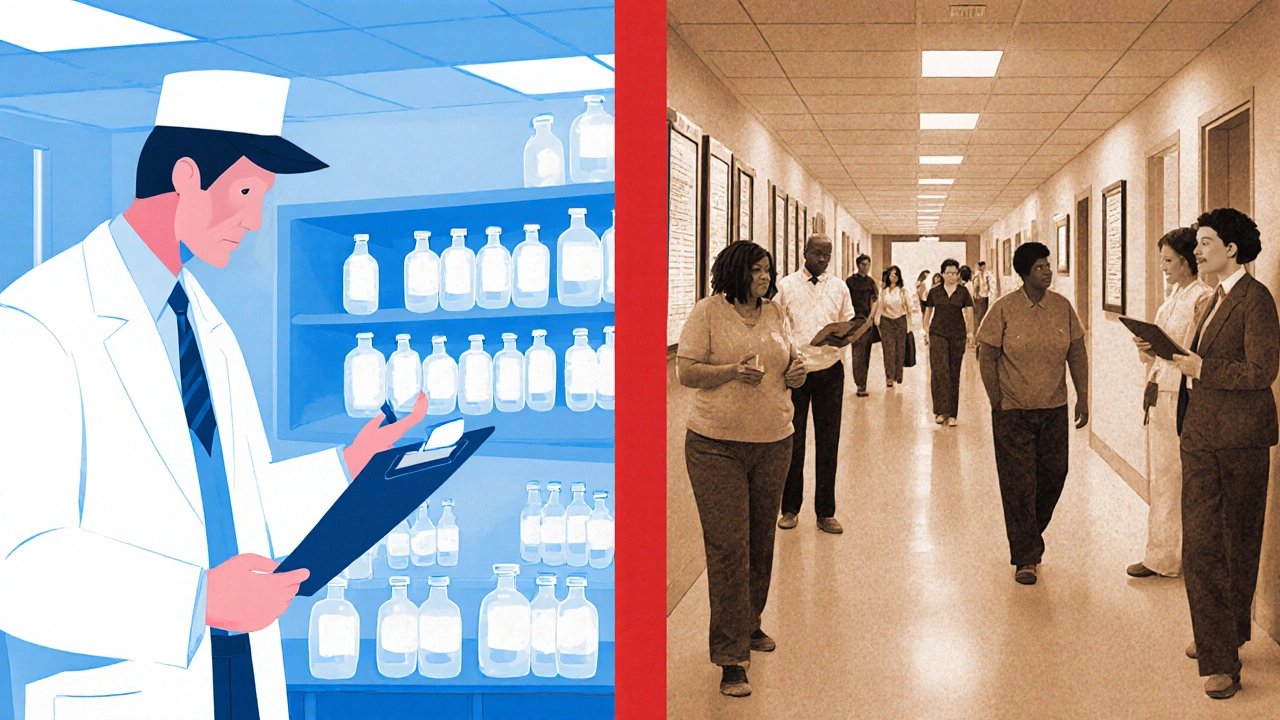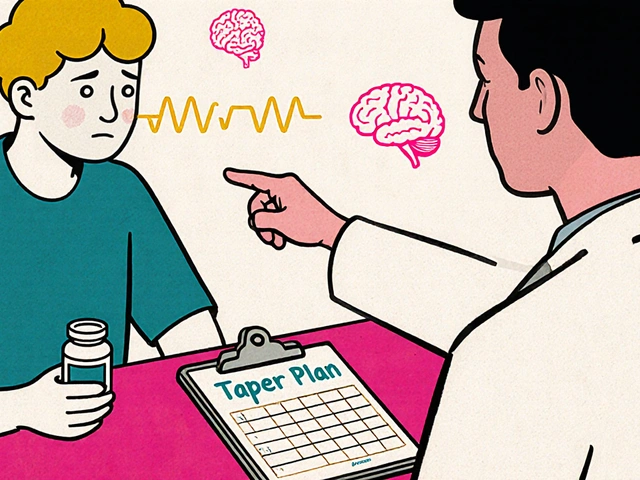Clinical Trial vs Real-World Patient Comparison Tool
Patient Population Calculator
Clinical trials typically exclude up to 80% of real-world patients. This tool demonstrates the difference in patient populations.
Key Takeaways
- Clinical trials provide high internal validity but limited external relevance because of strict enrolment rules.
- Real‑world evidence captures everyday practice across diverse patients, but data quality and bias are larger concerns.
- Regulators increasingly blend both sources; the FDA and EMA now accept RWE for safety and efficacy supplements.
- Hybrid designs can cut study costs by up to 25% while preserving statistical power.
- Successful adoption requires robust data‑linkage, transparent methods, and AI‑driven analytics.
When a new drug hits the market, most clinicians first hear about its effectiveness from the headline results of a clinical trial. Yet a growing number of decision‑makers ask, "Does the drug work for my patients in the real world?" The answer lies in understanding what real-world evidence really means, how it differs from the data generated in controlled trials, and why both are essential for modern healthcare.
What Are Clinical Trial Data?
Clinical trial data is information gathered from a protocol‑driven study that tests a medical intervention under tightly controlled conditions. Researchers decide who can join, what dosage is given, how often patients are seen, and which outcomes are measured. Randomisation, blinding, and predefined endpoints aim to eliminate bias, giving the trial high internal validity. Because the first modern randomized controlled trial (RCT) was formalised by Sir Austin Bradford Hill in the 1940s, the RCT remains the regulatory gold standard for safety and efficacy.
What Is Real‑World Evidence?
Real‑world evidence (RWE) refers to observational data collected outside the rigid confines of a trial, reflecting how a therapy performs in routine clinical practice. Sources include electronic health records (EHR), insurance claims, patient registries, wearables, and mobile health apps. The U.S. FDA highlighted RWE’s potential in the 21st Century Cures Act of 2016, and since then its use for post‑marketing safety and even efficacy supplements has exploded.
Methodological Contrasts
Both approaches answer different questions. An RCT asks, "Does the drug work under ideal conditions?" while RWE asks, "Does it work for the patients who actually receive it?" This dichotomy translates into several measurable differences:
- Population selection: RCTs typically exclude up to 80 % of real patients because of comorbidities, age limits, or strict performance status. In contrast, RWE studies can include anyone who shows up in an EHR system.
- Data completeness: In trials, primary‑endpoint data capture exceeds 90 % due to scheduled visits. Real‑world datasets often achieve only 60‑70 % completeness because records are entered for clinical, not research, purposes.
- Timing of measurements: Trials record outcomes at fixed intervals (e.g., every 3 months). RWE data points arrive irregularly; a diabetes study showed an average of 5.2 months between lab draws in EHRs.
- Bias control: Randomisation and blinding virtually eliminate confounding in RCTs. Real‑world analyses rely on statistical tricks like propensity‑score matching to mimic a balanced comparison.
These contrasts were quantified in a 2024 Scientific Reports analysis of 5,734 diabetic‑kidney patients in trials versus 23,523 patients in EHRs, which found significant gaps in prevalence, longitudinality, and sampling density (p < 0.001).
Key Data Sources and Quality Challenges
The backbone of RWE is the Electronic Health Records (digital versions of patients’ charts that capture diagnoses, prescriptions, lab results, and clinician notes. In the United States, claims databases from Optum, IQVIA, and Truven together cover about 270 million lives. Patient registries, such as the oncology registry run by Flatiron Health, aggregate data from thousands of clinics and have become pivotal for cancer research.
However, data quality can vary wildly. The NIH warns that EHR‑based RWE studies face difficulties controlling for biases that may affect outcomes, prompting the need for meticulous data cleaning, variable harmonisation, and transparent methodology. Only 35 % of healthcare organisations now have dedicated RWE teams, according to a 2023 Deloitte survey.
Regulatory Landscape: FDA, EMA, and Beyond
The Food and Drug Administration (U.S. agency responsible for protecting public health by ensuring safety and efficacy of drugs and medical devices has moved from a purely trial‑centric stance to actively accepting RWE. Between 2019 and 2022 the FDA approved 17 drugs with RWE components, up from just one in 2015. Its Sentinel Initiative, launched in 2008, now monitors roughly 300 million patient records across 18 data partners for post‑market safety.
Across the pond, the European Medicines Agency (EU body that evaluates and supervises medicinal products for human use has been more aggressive: 42 % of post‑authorisation safety studies in 2022 incorporated real‑world data, versus 28 % at the FDA. The EMA’s Adaptive Pathways programme even allows real‑world evidence to support accelerated approvals for high‑need therapies.
Both agencies now publish guidance on data quality, encouraging the use of propensity‑score methods, pre‑specified analysis plans, and, increasingly, AI‑driven validation.
Practical Implications for Stakeholders
Pharmaceutical companies see cost savings: a Phase III trial averages $19 million and 24-36 months, while a comparable RWE study can be finished in 6-12 months at 60-75 % lower cost. Moreover, integrating RWE early can shrink the required sample size by 15-25 % through prognostic and predictive enrichment, as shown by ObvioHealth in 2022.
Clinicians benefit from evidence that reflects the patients they actually treat, especially for under‑represented groups. A 2023 NEJM study found only 20 % of cancer patients would meet typical trial inclusion criteria, with Black patients excluded at 30 % higher rates.
Payers increasingly demand RWE to prove cost‑effectiveness. A 2022 Drug Topics survey reported 78 % of U.S. payers use RWE when setting formularies.
Patients gain transparency-real‑world data can reveal safety signals earlier, such as rare adverse events that never appear in trials with limited sample sizes.
Hybrid Designs and the Future
Rather than pitting RCTs against RWE, experts now champion a blended model. The FDA’s 2024 draft guidance on hybrid trials encourages sponsors to embed real‑world data collection within the trial itself, using wearables or linked EHRs to capture outcomes beyond the protocol schedule.
Artificial intelligence further accelerates this convergence. Google Health’s 2023 study demonstrated AI algorithms could predict treatment response from EHR data with 82 % accuracy, edging out traditional RCT analyses at 76 %.
Nevertheless, challenges remain. A Nature Communications analysis in 2023 reported 63 % of attempts to merge RCT and RWD datasets failed due to mismatched data generation mechanisms. Careful harmonisation, common data models, and transparent reporting are essential.
Side‑by‑Side Comparison
| Aspect | Clinical Trial Data | Real‑World Evidence |
|---|---|---|
| Primary Goal | Establish efficacy and safety under controlled conditions | Assess effectiveness and safety in routine practice |
| Population | Highly selected, often excludes comorbidities and older adults | Broad, includes all patients seen in participating health systems |
| Data Source | Study‑specific case report forms, scheduled visits | EHRs, claims, registries, wearables, mobile apps |
| Internal Validity | Very high (randomisation, blinding) | Variable; relies on statistical adjustments |
| External Validity | Limited; may not reflect real patient diversity | High; captures real‑world heterogeneity |
| Cost & Timeline | ~$19 M, 24‑36 months (Phase III) | $4‑7 M, 6‑12 months (typical) |
| Regulatory Acceptance | Mandatory for approval | Supplementary; growing acceptance (FDA, EMA) |
Practical Tips for Using Real‑World Evidence
- Start with a clear research question that complements, not replaces, trial data.
- Choose data sources with high completeness for your endpoint (e.g., lab‑derived outcomes from EHR).
- Apply rigorous confounding controls-propensity‑score matching, instrumental variables, or advanced machine‑learning adjustments.
- Document data‑quality assessments as required by the FDA’s 2023 RWE Framework.
- Partner with organisations that have mature data‑linkage platforms, such as Flatiron Health for oncology or Sentinel for safety monitoring.
Frequently Asked Questions
Can real‑world evidence replace randomized trials?
No. RWE provides complementary information about effectiveness and safety in broader populations, but regulators still require RCT data for initial efficacy and safety proof.
What are the main sources of real‑world data?
Electronic health records, insurance claims, disease registries, wearable device streams, and patient‑reported outcomes collected via apps are the most common sources.
How do researchers control bias in observational studies?
Techniques include propensity‑score matching, inverse‑probability weighting, instrumental variable analysis, and increasingly, AI‑driven causal inference models.
What is a hybrid trial?
A hybrid trial blends traditional randomised elements with real‑world data collection, often using linked EHRs or digital health tools to capture outcomes beyond the study schedule.
Are there cost benefits to using RWE?
Yes. Compared with a typical Phase III trial, an RWE study can reduce costs by 60‑75 % and shorten timelines by half, while still delivering actionable insights for payers and clinicians.
Understanding the strengths and limits of both clinical trial data and real‑world evidence equips anyone-from drug developers to bedside physicians-to make smarter, evidence‑based decisions. The future isn’t a battle between the two; it’s a partnership where each fills the gaps the other leaves behind.






Benjamin Sequeira benavente
October 24, 2025 AT 20:32Take the power of real‑world evidence and run with it-combine the rigor of trials with the breadth of everyday practice to push innovations faster than ever before.
Abhinav B.
November 1, 2025 AT 15:26Even in our bustling clinics in India you can see how RWE fills the gaps that trials miss, especially when patients have comorbidities that would disqualify them from a strict protocol.
Lisa Woodcock
November 9, 2025 AT 10:20Balancing the internal validity of RCTs with the external relevance of RWE helps clinicians make decisions that truly reflect the diversity of our patient populations.
Sarah Keller
November 17, 2025 AT 05:14When we step back and consider the philosophical underpinnings of evidence, we realize that no single method can claim absolute truth; each offers a piece of a larger mosaic. Clinical trials give us a controlled snapshot, a meticulously crafted experiment that isolates variables and establishes causality. Real‑world evidence, on the other hand, paints a dynamic portrait of how therapies behave across the messy spectrum of human health. By integrating the two, we honor both the precision of the laboratory and the lived experience of patients. This synergy encourages inclusive mentorship, inviting junior researchers to explore hybrid designs early in their careers. It also invites ethicists to weigh the trade‑offs between data purity and patient representation. Practically, the cost savings from RWE can be redirected toward expanding trial enrolment for under‑represented groups. Moreover, AI‑driven analytics can harmonize disparate datasets, reducing bias while preserving the richness of observational data. Regulatory bodies are already signalling support, with the FDA’s draft guidance on hybrid trials emphasizing transparency and pre‑specified analysis plans. The result is a more robust evidence ecosystem where each data source validates and extends the other. Researchers gain confidence that reported efficacy is not an artifact of ideal conditions but holds true when faced with comorbidities, polypharmacy, and varying adherence. Clinicians receive actionable insights that respect the heterogeneity of the populations they serve. Payers can base coverage decisions on outcomes that matter in real practice, not just surrogate endpoints. Patients benefit from earlier detection of rare adverse events that large trials might miss. In short, embracing both realms equips the entire health‑care continuum to make smarter, more equitable decisions.
Veronica Appleton
November 25, 2025 AT 00:07For anyone getting started, focus on clean data pipelines and use propensity‑score matching to control for confounding-these steps will make your RWE analysis much more credible.
ram kumar
December 2, 2025 AT 19:01Alas, the endless stream of noisy registries makes one wonder if we are chasing shadows rather than substance, a tragic comedy of over‑hyped analytics.
Deborah Galloway
December 10, 2025 AT 13:55Your patients will thank you for evidence that actually reflects their daily lives and not just the idealized world of a trial.